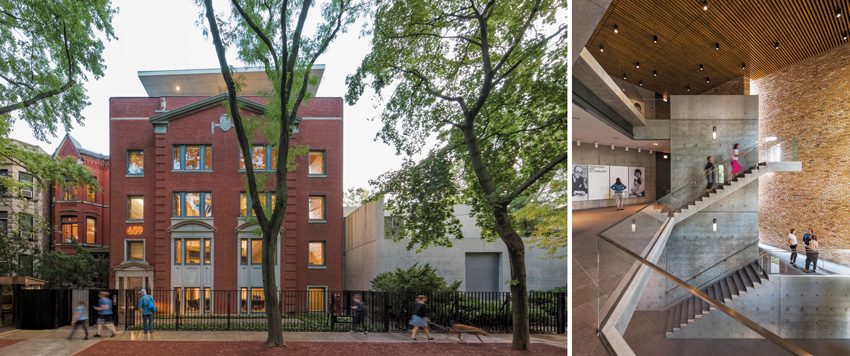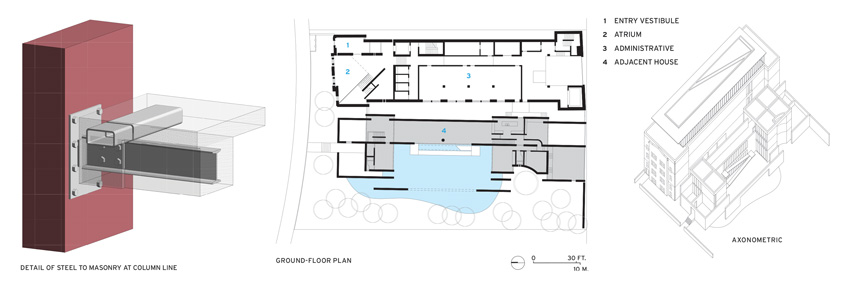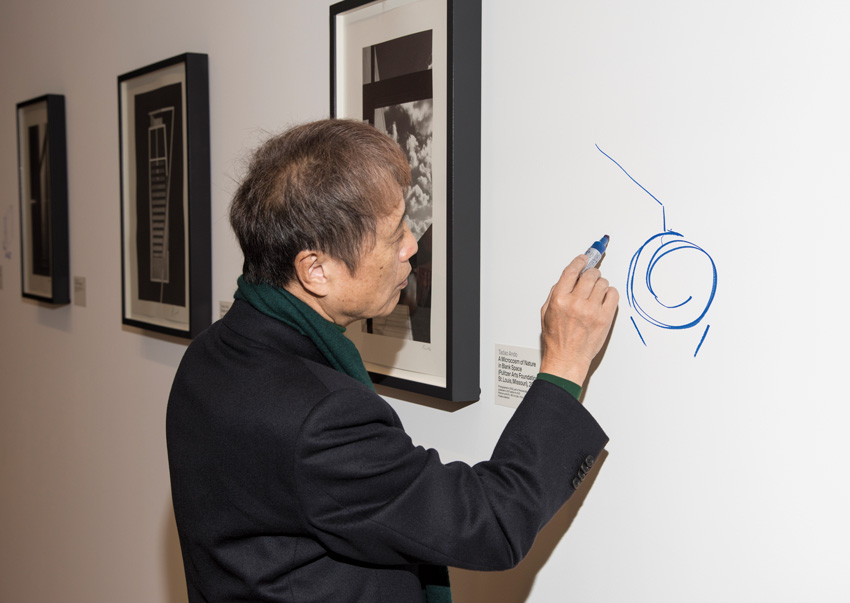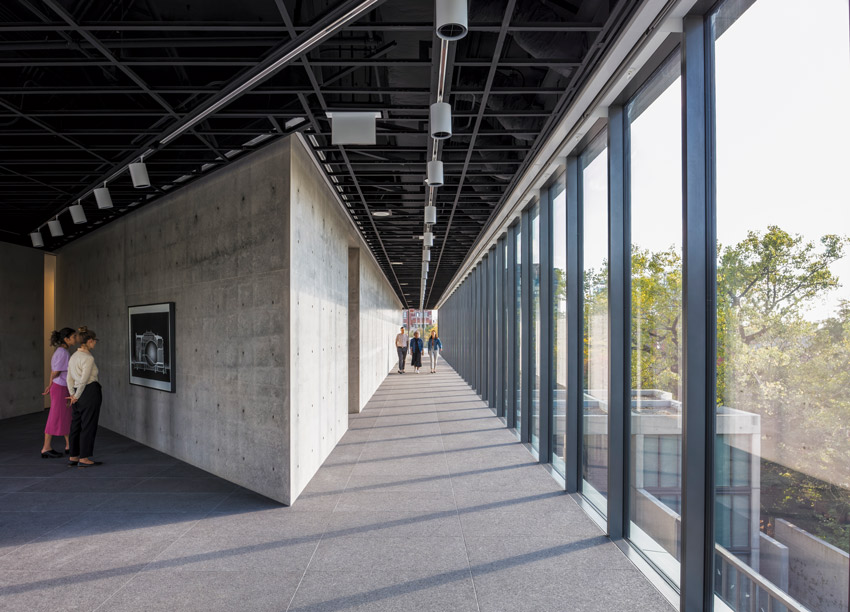Expressive Structure
The Big Reveal
An ordinary apartment building on a quiet block is revamped as a stunning space for art.
Wrightwood 659 | Chicago | Tadao Ando Architect & Associates
By Naomi Pollock, FAIA
Photography By Jeff Goldberg
From the street, Wrightwood 659 reads as a typical Chicago apartment building from the 1920s. But behind this anonymous redbrick wrapping stands a privately-owned gallery designed by the Pritzker Prize–winner Tadao Ando. Dedicated to architecture and socially engaged art, the gallery interior takes visitors entirely by surprise. Its big reveal is a soaring three-story atrium extending the original building’s full height and clad entirely with Chicago common brick. Walking a fine line between showcasing the new while respecting the old, this jaw-dropping space turns the mundane into the monumental.

OUTSIDE IN
The redbrick apartment building sits next door to the same client’s concrete house (left). The soaring atrium and its stair is the pièce de résistance of Ando’s design (right).
Based in Chicago’s sister city of Osaka, Japan, the architect has a long history with the Windy City, home to his first two built works in the United States: the Art Institute’s Japanese-screen gallery, which opened in 1992, and a house for philanthropist and activist Fred Eychaner, completed in 1997. Some 15 years later, Eychaner asked Ando to turn his adjacent property, a 38-unit apartment building, into an art venue. The catch was, the building’s brick exterior had to stay. “We wanted to respect the context of the mixed, residential street,” explains Eychaner.

“I thought this would be difficult,” says Ando, “but I really felt that the brick walls symbolized Chicago.” His response was to gut the interior completely, insert a new concrete-and-steel structure, and pop up an additional floor, penthouse-style. This building-within-a-building concept is reminiscent of other Ando projects, such as Venice’s Punta della Dogana, Paris’s Bourse de Commerce, and the Ando Museum on the island of Naoshima in Japan—a traditional wood house turned concrete-lined gallery. Though larger in scale, Wrightwood 659’s residential interior underwent a similar rebirth.
This time, the building opens with a vestibule that leads to the atrium, where a concrete stair tower ascends to the second and third floors. While support functions fill out the first floor, both upper levels contain lobby-like balconies followed by pristine, white-walled galleries sandwiched between narrow slots of mechanical and circulation space. The third-floor gallery culminates in an elevated double-height area that can serve as an informal stage. From there, stairs go up to the skylit fourth-floor gallery, followed by a lobby and a corridor linking roof terraces at either end. Reconnecting with the city, the north terrace opens to the street’s tree canopy, the south to a skyline view toward downtown, and the corridor to the client’s adjacent home and reflecting pool.

PHOTOGRAPHY: © MITCHELL CANOFF
THE MASTER’S HAND
Ando is photo-graphed inside the new gallery.
All four floors (plus the basement) are supported by a composite concrete-and-steel structural system. To stabilize the brick walls, a bracing frame needed to be built before the innards could be demolished. This entailed strategically cutting holes in the existing interior walls, floors, and the roof, and then using those openings to construct a three-dimensional grid of steel girts and flange columns that anchor the exterior walls. After deconstruction, this steel skeleton was utilized as the permanent structure by spanning the beams with poured-in-place concrete joists connected with cast-in-place joints. “This [method] was more expensive, due to the formwork, but it has high load capacities,” explains William Bast, a principal at Thornton Tomasetti, the project’s structural engineer.

The brick-clad atrium culminates in a wood-lined ceiling (left). The inaugural exhibition showcases Ando’s work, including his Chichu Art Museum in Naoshima, Japan (right).
For additional strength, as well as for its aesthetic qualities, the steel columns were also encased in concrete. While steel micro-piles transfer the vertical load to bedrock, push piles fortify the foundations beneath the brick walls. This extra bolstering was essential, since the live loads of the old apartments were considerably less than the bearing capacity of 300 pounds per square foot the client requested for the anticipated art installations. Measuring 18 inches thick, the atrium walls incorporate the existing masonry plus an additional layer of tan-colored bricks, salvaged during demolition.

ON DISPLAY
For additional strength as well as aesthetics, steel columns were encased in concrete (left). The upper-floor gallery is skylit (right).
To help meet the gallery’s interior climate requirements and prevent condensation, the engineers devised thermally broken connections between the new steel elements and the existing masonry wall. These consist of a face-mounted plate attached with stainless-steel adhesive anchors and separated from the outer masonry with a nonconductive shim. The inner, salvaged bricks are mounted with rigged back joints and ¾-inch-deep recessed mortar, creating deep shadows when illuminated, turning a utilitarian material into a rich interior finish.

A story was added to the existing structure, offering views of Chicago’s skyline and of the client’s concrete house next door, also designed by Ando.
Fittingly, Wrightwood 659’s inaugural exhibit, Ando and Le Corbusier: Masters of Architecture, pairs Ando with the architect who influenced him profoundly. Though the two never met–Le Corbusier died just prior to Ando’s first visit to Paris in 1965–the parallels between their emotive concrete forms and elegant use of light are underscored by showing their works in tandem. Washington University professor Eric Mumford curated the Le Corbusier displays, while architectural historian Dan Whittaker selected the Ando buildings, culminating in Ando’s three major museums in the United States: the Pulitzer Arts Foundation in St. Louis, the Modern Art Museum of Fort Worth, and the Clark Art Institute in Williamstown, Massachusetts. The exhibit “helps you to understand Ando’s work as part of the continuum of the history of modern architecture,” explains Mumford.
It also highlights Ando’s great admiration for Le Corbusier. Yes, his architecture has been an inspiration for Ando, but even more has been Corb’s willingness to go against convention. Le Corbusier “was very brave and kept fighting; I really applaud his courage,” explains Ando. An outstanding achievement that will inspire others, Wrightwood 659 too is the product of an architect with a courageous spirit and iron will.
Credits
Architect: Tadao Ando Architect & Associates — Tadao Ando; Masataka Yano, principal; Kazutoshi Miyamura, associate
Associate Architect: Vinci|Hamp Architects, Gensler
Engineers: Thornton Tomasetti (structural); AEI (m/e/p)
General Contractor:Norcon
Client: CFAB — Fred Eychaner, Daniel J. Whittaker
Size: 37,200 square feet
Cost: withheld
Completion Date: May 2018









